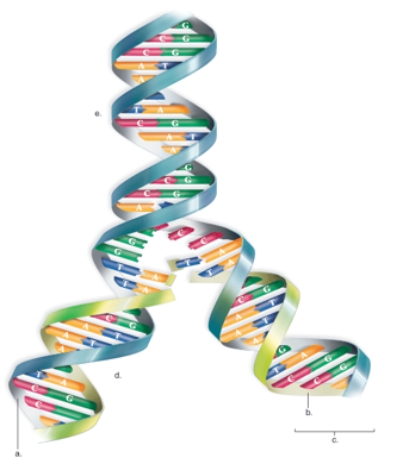A) RNA is converted into DNA information.
B) RNA is converted into protein information.
C) DNA is converted into RNA information.
D) protein is converted into RNA information.
E) DNA is converted into protein information.
G) A) and C)
Correct Answer

verified
Correct Answer
verified
Multiple Choice
Although DNA replication of one cell involves billions of nucleotides,why is this process so accurate?
A) DNA primers can replace any mistakes in base-pairing
B) RNA polymerase corrects any mistakes before doing RNA transcription
C) Unwinding the double helix would remove any mistakes in base-pairing.
D) DNA polymerase proofreads and corrects mistakes in base-pairing.
E) Semiconservative replication means that the process is very careful and conservativE.
G) C) and E)
Correct Answer

verified
Correct Answer
verified
Multiple Choice
The X-ray diffraction of Rosalind Franklin and Maurice Wilkins was critical evidence
A) that indicated that DNA has a double helix structure.
B) that showed that the bases of DNA are held together by hydrogen bonds.
C) that showed that there was an equal numbers of purines and pyrimidines in DNA.
D) that showed the location of each adenine,guanine,cytosine,and thymine.
E) that revealed the structure of deoxyribose sugar.
G) B) and D)
Correct Answer

verified
Correct Answer
verified
Multiple Choice
Which statement would have to be changed if found in a Biology textbook?
A) They can cause point mutations.
B) They can cause deletions and translocations.
C) They can block transcription.
D) They can cause frameshift mutations.
E) They contain antibiotic-resistance genes.
G) B) and D)
Correct Answer

verified
A
Correct Answer
verified
Multiple Choice
What type of mutation changes the base of a single DNA nucleotide,which then causes a change in a specific codon?
A) translocation mutation
B) frameshift mutation
C) point mutation
D) polymerase mutation
E) transposon mutation
G) A) and E)
Correct Answer

verified
Correct Answer
verified
Multiple Choice
Figure:  -In this figure showing DNA replication,what does "E" represent?
-In this figure showing DNA replication,what does "E" represent?
A) the parental DNA region
B) the new strand
C) the replication region
D) the template strand
E) the completed DNA region
G) A) and C)
Correct Answer

verified
Correct Answer
verified
Multiple Choice
Which enzyme is responsible for building the mRNA transcript from individual nucleotides?
A) ligase
B) RNA polymerase
C) ribozymes
D) helicase
E) DNA polymerase
G) A) and B)
Correct Answer

verified
B
Correct Answer
verified
Multiple Choice
In semiconservative DNA replication,each new double helix formed will have
A) three new strands in one helix and three old strands in the second helix.
B) one new strand and one old strand in each helix.
C) two new strands and two old strands in each helix.
D) two new and one old strand in one helix and two old and one new in the second helix.
E) only new strands in each helix.
G) All of the above
Correct Answer

verified
Correct Answer
verified
Multiple Choice
What is the error rate in the DNA replication process,for eukaryotes?
A) one in 1 billion nucleotides
B) one in 1 hundred nuclotides
C) one in 1 thousand nucleotides
D) one in 10,000 nucleotides
E) one in 1 million nucleotides
G) C) and D)
Correct Answer

verified
Correct Answer
verified
Multiple Choice
What process results in the assembly of a protein chain?
A) replication
B) translation
C) translocation
D) mutation
E) transcription
G) C) and D)
Correct Answer

verified
Correct Answer
verified
Multiple Choice
Movable genetic elements are referred to as
A) frameshift mutations
B) point mutations
C) transcription elements
D) translocation elements
E) transposons
G) C) and D)
Correct Answer

verified
Correct Answer
verified
Multiple Choice
The step which brings all the translation elements together is referred to as
A) elongation.
B) initiation.
C) replication.
D) translocation.
E) transcription.
G) A) and E)
Correct Answer

verified
Correct Answer
verified
Multiple Choice
Which statement,if true,would lead to serious problems in DNA replication?
A) Unwinding of the DNA molecules occurs as hydrogen bonds break.
B) The process is known as semiconservative replication because one old strand is conserved in the new molecule.
C) Replication occurs as each base is paired with another exactly like it.
D) Complementary base pairs are held together with hydrogen bonds.
E) The enzyme that catalyzes DNA replication is DNA polymerasE.
G) A) and E)
Correct Answer

verified
Correct Answer
verified
Multiple Choice
During the process of translation,the information in
A) DNA is converted into RNA information.
B) RNA is converted into protein information.
C) DNA is converted into protein information.
D) protein is converted into RNA information.
E) RNA is converted into DNA information.
G) A) and C)
Correct Answer

verified
Correct Answer
verified
Multiple Choice
Initiation,elongation,and termination are three stages in
A) DNA replication.
B) codon-anticodon formation.
C) mRNA transcription.
D) error correction by proofreading enzymes.
E) polypeptide synthesis.
G) C) and D)
Correct Answer

verified
Correct Answer
verified
Multiple Choice
The DNA sequences of a gene that do not code for amino acids in a protein are called
A) promoters.
B) introns.
C) transposons.
D) inducers.
E) exons.
G) C) and E)
Correct Answer

verified
Correct Answer
verified
Multiple Choice
Which nucleotide is found in RNA rather than DNA?
A) thymine
B) adenine
C) uracil
D) cytosine
E) guanine
G) A) and C)
Correct Answer

verified
Correct Answer
verified
Multiple Choice
How many DNA bases are in each codon?
A) 3
B) 16
C) 4
D) 20
E) 64
G) B) and E)
Correct Answer

verified
A
Correct Answer
verified
Multiple Choice
Which process in translation is the movement of the ribosome,such that the tRNA at the A site moves to the P site?
A) initiation.
B) translocation.
C) replication.
D) transcription.
E) mutation.
G) A) and C)
Correct Answer

verified
Correct Answer
verified
Multiple Choice
The enzyme that is used to join successive DNA nucleotides together is which?
A) DNA polymerase
B) Lipase
C) RNA polymerase
D) Ribozyme
E) Helicase
G) B) and E)
Correct Answer

verified
Correct Answer
verified
Showing 1 - 20 of 49
Related Exams